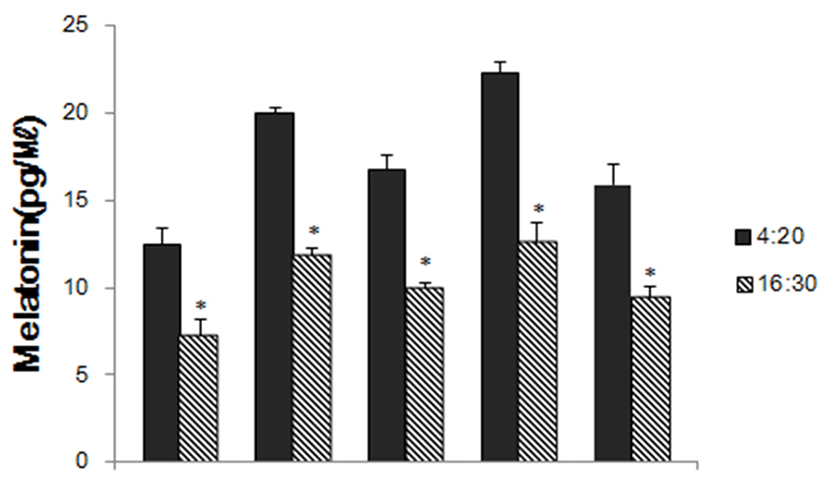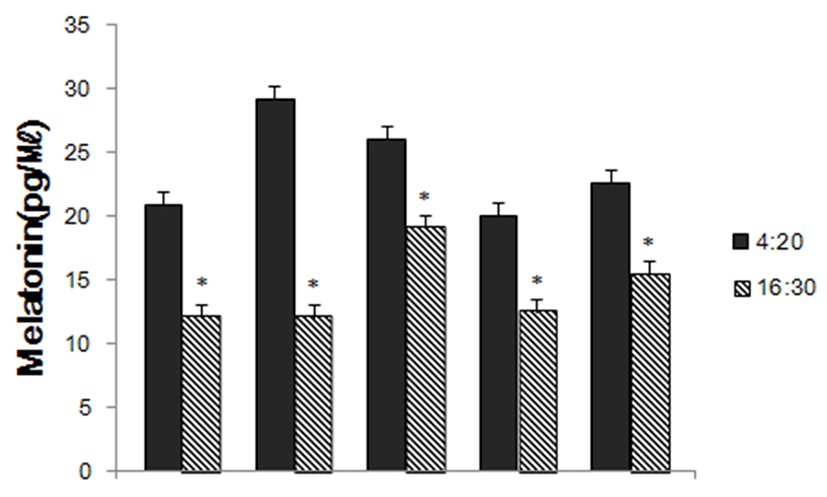서 론
일주기 리듬(circadian rhythm)은 24시간을 주기로 반복되는 생체현상으로 체온과 호르몬 변화를 통해 조절되며, 체내에서 일정한 패턴의 생체리듬을 나타나게 한다. 빛은 생체리듬에 영향을 주는 중요한 요인 중 하나이며, 이에 민감하게 반응하는 호르몬들을 매개로 하여 생리적 기능을 조절한다.
멜라토닌(melatonin)은 뇌의 송과선(pineal gland)에서 arylalkyl- amine-N-acetyltransferase(AANAT) 및 hydroxyindole-O-methyl transferase(HIOMT) 효소의 작용을 받아 세로토닌(serotonin)으로부터 합성된다. 이 두 효소는 빛에 의해 활성이 저해되므로 체내 멜라토닌 농도는 빛의 유무에 따라 영향을 받는다. 즉, 멜라토닌의 합성과 분비는 암기에 촉진되고, 명기에 억제된다(Wurtman et al., 1963; Kim et al., 2013). 멜라토닌의 대표적인 생리적 기능으로는 신체를 이완시키고, 수면을 유도하는 것이다. 노화가 진행되면 멜라토닌 농도는 낮아지게 되고, 이로 인해 노인에게서 노화에 의한 불면증(age-related insomnia)이 빈번하게 유발된다. 노인을 대상으로 한 선행 연구에 따르면, 외인성 멜라토닌 투여를 통해 혈청 멜라토닌 농도를 정상적인 암기의 혈청 멜라토닌 수준으로 높였을 때, 불면증이 개선됨을 확인하였다(Zhdanova et al., 2001).
코티솔(cortisol)은 부신피질에서 분비되며, 체내 대사속도에 큰 변화가 없을 경우, Adrenocorticotropic hormone(ACTH)의 분비 자극에 따라 체내 농도가 결정된다. ACTH의 경우, 주로 스트레스에 의해 분비가 촉진되므로 코티솔 농도 또한 생체 스트레스에 크게 영향을 받는다고 할 수 있다(Lee et al., 2010). 코티솔 농도는 스트레스 요인뿐만 아니라, 빛에 의해서도 영향을 받으며, 멜라토닌과 마찬가지로 일주기 리듬을 가진다. 일반적으로 코티솔 농도는 저녁에 높아지기 시작하여 기상 후 1시간 이내에 최고조에 이르는 패턴을 보인다(Elverson et al.,2005). 건강한 성인을 대상으로 한 선행연구들에 따르면 빛에 노출되었을 때 대조군에 비해 타액 또는 혈청 내 코티솔 농도가 유의적으로 높아졌다(Lockley et al., 2006; Clow et al., 2004).
본 연구에서는 계절 및 착유시간에 따른 원유 내 멜라토닌 및 코티솔 농도를 비교 분석함으로써 긴장 완화 및 수면의 질 개선에 도움을 줄 수 있는 우유의 기능성 식품으로써의 개발 가능성을 살펴보고자 하였다. 또한, 우유를 분말화하여 저장성이 높은 분유 내 멜라토닌 및 코티솔 농도를 비교 분석함으로써 열처리 공정에 의해 멜라토닌 및 코티솔 농도가 유지되는지 살펴보았다.
재료 및 방법
경기도 서남부 지역에 위치한 2개의 목장(목장 A, B)에서 사육 중인 젖소(dairy cow)를 대상으로 각 목장의 개체 5두로부터 원유 샘플을 취하였다. 동지(winter solstice)와 하지(summer solstice) 무렵에 각각 샘플을 취하여 계절에 따른 원유 내 멜라토닌, 코티솔 농도를 비교분석하였다. 또한, 각 호르몬의 일주기 리듬을 파악하기 위하여 일몰 전 명기(light period)와 일출 전 암기(dark period)에 원유를 착유하였다. 암기는 하지의 경우, 착유 당일 일출 시간인 오전 5시 10분 이전, 동지는 착유 당일 일출 시간인 오전 7시 15분 이전으로 설정함으로써 젖소가 빛에 노출되는 것을 최소화하였다.
분무건조기(SD Pilot 2010, Ein system co. Ltd., Korea)를 활용하여 원유를 분말화 하였다. 분무건조 조건은 inlet temperature의 경우, 180~190℃로 조절하였고, outlet temperature는 80~90℃, 시료공급 속도는 12mL/min으로 하였다.
결과 및 고찰
착유시간에 따른 원유 내 멜라토닌 함량을 비교 분석한 결과는 Fig. 1과 같다. 모든 개체에서 명기에 비해 암기에 착유한 원유에서 멜라토닌 함량이 유의적으로 높아졌다. 이는 염소를 대상으로 한 선행연구 결과와 일치한다(Alia-Johansson et al., 2006). 자연적인 조건에서의 광주기(photoperiod) 정보를 바탕으로 인공 광원을 활용하여 명기와 암기를 조절하였고, 2시간 간격으로 혈청 내 멜라토닌 함량을 분석하였다. 그 결과, 계절에 관계없이 명기에 비해 암기에 혈청 내 멜라토닌 함량이 유의적으로 높아졌다. 또한 본 연구와 동일하게 젖소를 대상으로 한 선행연구에서도 명기에 비해 암기에 우유 및 혈청 내 멜라토닌 농도가 유의적으로 높아졌다(Castro et al., 2011; Milagres et al., 2014). 그 밖에도 사람을 포함한 다양한 포유동물을 대상으로 한 선행연구에서도 혈청 내 멜라토닌 농도는 동일한 일주기 경향을 보였다(Knauer et al., 1980; Tamarkin et al., 1978). 멜라토닌은 일주기 리듬을 가지고 있으며, 빛에 민감한 호르몬이다. 성인남자를 대상으로 한 선행연구에 따르면, 300 lux 또는 2,500 lux의 빛을 조사하였을 때, 혈청 내 멜라토닌 및 멜라토닌 대사체인 aMT6 농도가 유의적으로 감소하였다. 또한, 빛을 다시 차단하였을 때 2,500 lux의 빛을 조사하였을 때에 비해 300 lux의 빛을 조사하였을 때, 멜라토닌 및 aMT6 농도의 빠른 회복을 보였다(Boikowski et al., 1987). 이와 같은 멜라토닌의 빛에 대한 높은 민감성은 일출 전 새벽 착유 우유에서 멜라토닌 농도가 높아지는데 영향을 미친 것으로 보인다.

본 논문에서 그림으로 제시하지는 않았지만, 동지에 목장 B의 개체들을 대상으로 한 연구 결과는 앞서 언급했던 하지에 목장 A의 개체들을 대상으로 실시한 연구 결과와 동일한 일주기 경향을 보였다. 동지 및 하지에 실시한 연구의 개체가 동일하지 않아 계절에 따른 개체 내 변화를 살펴보기는 어려웠다. 개체 간 변이가 크지 않다고 가정하고, 계절에 따른 우유 내 멜라토닌 농도 변화를 살펴본 결과, 유의적 차이는 나타나지 않았다. 하지만 Alia-Johansson 등(2006)에 따르면, 다른 계절과 달리 가조시간이 긴 여름에는 오전 2시 이후부터 혈청 내 멜라토닌 농도가 급격히 감소하기 시작하여 오전 4시에는 기저수준에 이르는 차이를 보였다. 이러한 선행연구 결과를 고려할 때, 동일한 개체를 대상으로 동지와 하지로 착유시기를 달리 하여 개체 내 변화를 살펴보는 추가 연구가 필요할 것으로 사료된다.
일출 전 새벽 착유 우유에서의 높은 멜라토닌 함량은 우유의 기능성 축산물로써의 개발 가능성을 보여준다고 할 수 있다. 최근 연구에 따르면, 멜라토닌은 체내의 각성 유발 메커니즘(wakefulness-generating mechanism)을 억제함으로써 수면에 도움을 주는 것으로 알려지고 있다(Blask, 2009). 국내의 경우, 멜라토닌은 전문 의약품으로 수면장애, 교대 근무로 인한 수면장애, 시차증후군(jet lag)과 같은 질환을 가진 사람들에게 처방되고 있다(Han, 2008). 앞서 언급한 연구 결과를 고려할 때, 우유는 합성 멜라토닌(synthetic melatonin)이 아닌 내인성 멜라토닌(endogenous melatonin)을 풍부하게 함유하고 있는 식품으로 의약품 대체 기능성 식품으로써의 발전 가능성이 높다고 할 수 있다.
Fig. 2는 명기와 암기에 착유한 원유를 분무 건조한 후, 정제수로 환원시켜 만든 환원유 내 멜라토닌 함량을 비교 분석한 결과이다. 원유와 마찬가지로 환원유 내 멜라토닌 농도 또한 착유시간에 따른 뚜렷한 일주기 리듬을 보였다. 하지만, 개체 및 착유시간에 관계없이 열처리하지 않은 원유에 비해 환원유 내 멜라토닌 농도가 높았고, 통계적으로도 가공처리 방법에 따른 유의적 차이가 나타났다. 본 연구에서는 멜라토닌 농도를 측정하는 방법으로 직접경쟁효소면역분석법(direct competitive ELISA)을 사용하였다. 이는 측정하고자 하는 단백질과 동일한 단백질에 효소를 결합시킨 효소표지물질이 시료 또는 표준 물질과 경쟁하는 원리를 바탕으로 한다(Shim et al., 2006). 일반적으로 대부분의 항체(antibody)는 항원이 3차 구조를 형성하고 있을 때에 비해, 변성에 의해 단백질 접힘(protein folding)이 풀어지며, 항원 결정기(epitope)가 노출되었을 때 잘 결합한다(Angenendt et al., 2003). 실질적으로 β-lactoglobulin의 경우, 열처리하지 않은 샘플에 비해 열처리한 샘플에서 항체에 대한 항원성(antigenicity)이 높아짐이 확인되었다(Bu et al., 2009; Lee et al., 2014). 원유와 달리 분무건조 열처리 공정을 거친 환원유 내 멜라토닌은 열변성(heat denaturation)이 일어났고, 궁극적으로는 열처리에 의해 멜라토닌의 항원성이 높아져 원유에 비해 환원유 내 멜라토닌 농도가 높게 측정된 것으로 보인다.

Table 1은 명기와 암기에 착유한 원유 및 환원유 내 코티솔 농도를 보여주고 있다. Table 1을 통해 알 수 있듯이, 멜라토닌과 달리 원유 및 환원유 내 코티솔 농도는 착유시간에 따른 유의적 차이를 보이지 않았다. 선행연구에 따르면, 코티솔도 멜라토닌과 마찬가지로 뚜렷한 일주기 리듬을 보이며, 빛에 민감하게 반응하는 호르몬 중 하나이다(Carlson et al., 2007; Touitou et al., 1990). 건강인을 대상으로 한 선행연구에 따르면, 멜라토닌과 코티솔은 뚜렷한 일주기 리듬을 보였다. 코티솔은 22:00~02:00 h에 가장 낮아졌고, 그 이후 조금씩 상승하여 06:00h~08:00 h에는 최고치에 이르는 경향을 보였다. 또한 05:00~08:00 h에 2,000 lux 이상의 강한 빛을 조사하였을 때 동일한 일주기 리듬을 보였지만, 빛을 조사하지 않았을 때에 비해 멜라토닌 농도는 빠르게 감소하였으며, 코티솔 농도는 빠르게 증가하였다(Leproult et al., 2001). 선행연구 결과와의 이러한 차이는 코티솔 농도가 빛 이외에도 스트레스나 운동이라는 요인에 의해서도 쉽게 영향을 받기 때문이라 사료된다. Strzelec 등(2010)에 따르면, 말(horse)은 운동을 하지 않았을 때에 비해 운동 시 타액 코티솔(salivary cortisol) 농도가 유의적으로 높아졌고, 운동의 강도 및 지속시간에 따라서도 유의적 차이를 보였다. 또한 젖소를 대상으로 한 선행연구 결과, 대조군에 비해 낯선 환경에서 집유하였을 때 혈청 내 코티솔 농도가 유의적으로 증가하는 것을 확인할 수 있었다(Rushen et al., 2001).
개체간 변이가 크지 않다고 가정하고, 일몰 전 명기에 착유한 우유의 계절에 따른 코티솔 함량을 비교 분석하였다. 그 결과, 동지에 비해 하지에 착유한 우유 내 코티솔 농도가 유의적으로 높았다. 이는 여름철 고온으로 인한 스트레스가 소의 코티솔 분비를 촉진시킨 것으로 사료된다. Preez 등(2000)이 실시한 선행연구에서도 높은 온도로 인한 스트레스가 젖소의 혈청 내 코티솔 농도를 높인다고 보고하고 있다.
요 약
본 연구에서는 착유시간에 따른 우유 및 환원유 내 멜라토닌 및 코티솔 농도 변화를 살펴보았고, 이를 바탕으로 긴장완화 및 수면의 질 개선 측면에서의 우유의 기능성 식품으로써의 개발 가능성을 탐색하였다. 연구 결과, 명기에 비해 일출 전 암기에 착유한 우유에서 멜라토닌 농도가 유의적으로 높았다. 환원유 내 멜라토닌 농도 또한 우유와 동일한 일주기 리듬을 보였으나, 전반적으로 우유에 비해 멜라토닌 농도가 높은 것을 확인할 수 있었다. 이에 반해 빛 이외에도 운동, 스트레스 등과 같은 요인에 의해 영향을 받는 코티솔은 착유시간에 따른 유의적 차이를 보이지 않았다. 하지만 개체간 변이가 크지 않다고 가정하였을 때, 동지에 비해 하지에 착유한 우유 및 환원유 내 코티솔 농도가 유의적으로 높았다. 이러한 연구 결과를 바탕으로 할 때, 집유 시간을 조정하여 생산한 야간 착유 우유는 내인성 멜라토닌이 풍부한 식품이며, 수면 유도에 도움을 줄 수 있는 기능성 식품으로써의 개발 가능성을 가지고 있는 것으로 사료된다. 하지만 본 연구는 착유시간에 따른 원유 및 환원유 내 멜라토닌 농도의 차이만을 보여줬다는 점에서 한계를 가진다. 그러므로 착유시간에 따른 이러한 차이가 실질적으로 우유를 섭취하였을 때, 체내의 수면유도 생리활성에 영향을 미치는지 추가적으로 살펴볼 필요가 있다. 또한, 계절에 따른 우유 내 각 호르몬의 변화를 정확히 파악하기 위하여 동일한 개체를 대상으로 한 추가 연구가 필요하다.
